|
Pseudaspis cana (Mole snake)
Molslang, Swartslang or Luislang [Afrikaans]; Inkwakhwa
[Xhosa]; uBhulube, umJungendlu [Zulu]
Life >
Eukaryotes
>
Opisthokonta >
Metazoa
(animals) > Bilateria > Deuterostomia >
Chordata >
Craniata > Vertebrata (vertebrates) > Gnathostomata (jawed vertebrates) >
Teleostomi (teleost fish) > Osteichthyes (bony fish) > Class:
Sarcopterygii (lobe-finned fish) > Stegocephalia (terrestrial vertebrates) >
Tetrapoda
(four-legged vertebrates) > Reptiliomorpha > Amniota >
Reptilia (reptiles) >
Romeriida > Diapsida > Lepidosauromorpha > Lepidosauria >
Squamata > Serpentes
(snakes) > Family: Colubridae > Subfamily:
Boodontinae
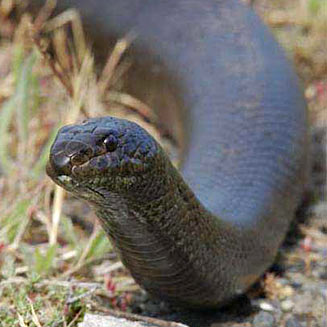 |
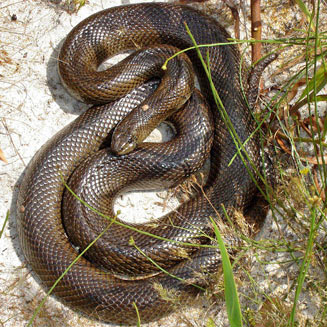 |
|
Pseudaspis cana (Mole snake), Western Cape
[K. Drummond-Hay ©, from
SARCA Virtual Museum] |
Pseudaspis cana (Mole snake), Western Cape
[M. Carstens ©, from
SARCA Virtual Museum] |
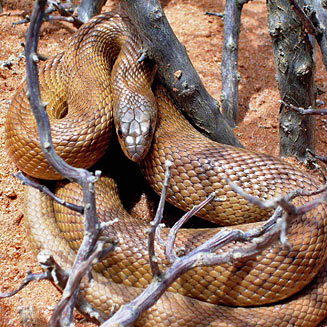 |
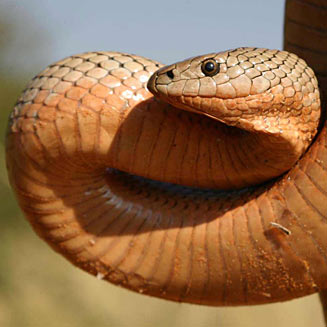 |
| Pseudaspis cana (Mole snake), Northern
Cape. [G. Diedericks ©, from
SARCA Virtual Museum] |
Pseudaspis cana (Mole snake), Kgalagadi,
Botswana. [M. Adams ©, from
SARCA Virtual Museum] |
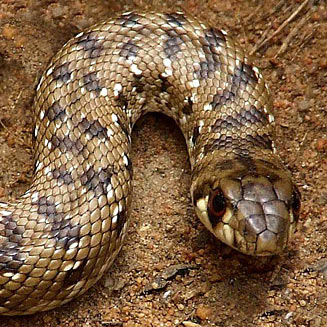 |
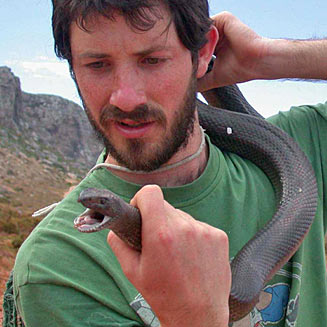 |
|
Juvenile Pseudaspis cana (Mole snake),
Western Cape [S. Steiner ©, from
SARCA Virtual Museum] |
Pseudaspis cana (Mole snake), Western Cape,
medium-sized specimen. [D. Gwynne-Evans ©,
from
SARCA Virtual Museum] |
Identification
The Mole snake can be identified by its uniform brown, grey
or black colour (juveniles have zigzag or mottled markings), its preference for
burrowing, a round pupil and highly aggressive self-defence display. It grows to
an average length of 1.4 meters but may reach 2 meters in length particularly in
the Cape.
Distribution and habitat
The distribution of this snake widespread, It is present
throughout southern Africa and in nearly all habitats. Its preferred habitat is
grassveld.
Food
Eats
rodents
(particularly
rats,
mice
and
gerbils),
moles and
birds. Juveniles however are largely restricted to lizards.
Predators, parasites and disease
Eaten by
birds of
prey (secretary
birds and
snake eagles), other snakes and mammalian predators such as
Black-jacked jackal (see photos below).
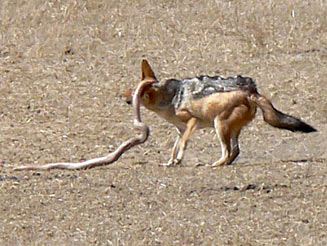 |
 |
|
This
Black-jacked jackal attacked this mole snake presumably to eat it
but as can be seen in the left-hand photo, the snake manage to bite the
jackal. After that the jackal had anothe go at subduing it - don't know
if it eventually managed to kill it and eat it. Photographed in
Kgalagadi Transfrontier Park by
Lorinda Steenkamp
©. |
Reproduction
Viviparous (gives birth to live young), gives birth to
between 25 and 50 young (or up to 95 in rare cases) in late summer.
Longevity
Has been known to live for 20 years in
captivity.
Medical importance
Non-venomous and not dangerous to man but can be very
aggressive and able inflict a painful bite.
Links
References
-
Broadley, D.G. 1983. FitzSimons' Snakes of Southern
Africa. Delta Books, Johannesburg.
-
Marais, J. 2004. A Complete Guide to Snakes of
Southern Africa. Struik Publishing, Cape Town.
|
